Imagine a group of 25 to 30 people, all in their early and mid-20s, working toward a common goal of developing their surroundings, educating people around them, identifying problems, and drawing possible solutions. This is the dream of 23-year-old Iswar Ghiuria from Gundalia Guda, a remote village in the Boipariguda Block of Koraput District, which he has made come true. With around 60 households, this village, like many remote villages, lacks proper connectivity. With barely any other livelihood options, the villagers are mostly small and marginal farmers whose annual income is solely dependent on a single crop harvest for the whole year. During the non-agricultural season, the men from the village move out in search of work as daily wage laborers to make ends meet.
Growing up in such an environment, Iswar developed a strong desire to make a positive impact on his villagers from a very young age. However, his lack of proper awareness and knowledge left him constantly perplexed about where and how to begin, which issues to prioritize, and how to find solutions. Ishwar reflects on this, saying, “I always wanted to contribute to the development of this village, but I felt lost in terms of how and where to start.”
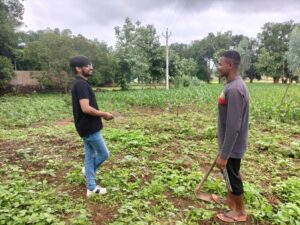 Iswar’s aspiration to improve his village caught the attention of CYSD’s community facilitators. When searching for an engaged community member, the residents of Gundalia Guda were determined that Iswar should become their community leader. Iswar admitted, “Initially, I had no idea what it meant to be a community leader or what responsibilities it entailed. However, I was thrilled to learn that this role could be my gateway to developing my village.”
Iswar’s aspiration to improve his village caught the attention of CYSD’s community facilitators. When searching for an engaged community member, the residents of Gundalia Guda were determined that Iswar should become their community leader. Iswar admitted, “Initially, I had no idea what it meant to be a community leader or what responsibilities it entailed. However, I was thrilled to learn that this role could be my gateway to developing my village.”
Through the training he received, Iswar has gained the ability to identify problems and their underlying causes, enabling him to formulate suitable solutions. Iswar emphasized that, among the village’s various issues, youth unemployment stands out as a major concern, followed by problems related to road connectivity, illiteracy, and water scarcity. He elaborated, saying, “Unemployment is the most pressing challenge in our village at present. People lack viable income sources since we rely on a single annual crop due to water scarcity during the summer season. Consequently, during non-agricultural periods, many young men from the village have to seek employment as daily wage workers. Additionally, our village lacks proper road infrastructure; all we have is a mud road, which becomes impassable even with minor rainfall.”
With this intention in mind, Iswar initially rallied the youth in the village to join forces with him. This led to the establishment of ‘The Youth Club Foundation,’ which currently boasts 30 active members. Through this youth club, they approached the village with potential solutions to various problems. Iswar shared his vision, saying, “Starting a youth club was always a dream of mine. The youth represent the workforce with the capacity and ability to take on challenging tasks and yield promising results. That’s why, I initiated this youth club, and it has undertaken several important initiatives.”
His efforts are noteworthy – the village now has an asphalt road. Iswar explained, “I took on the responsibility of addressing the issue of proper road connectivity. With the support of all the youth club members, we submitted an application to the Panchayat Office, requesting a proper asphalt road for our village.” Their hard work paid off, as the village received approval and funding of Rs. 24 Lakhs/- for road construction. Additionally, through this intervention, they secured employment opportunities under MGNREGS. In the coming months, the village will have a well-functioning road connecting it to the block headquarters.
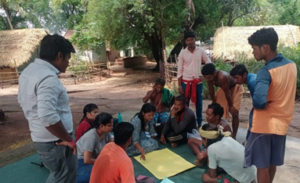 Iswar emphasized, “Once the road is constructed, I believe that many of the village’s problems can be resolved. Lack of proper connectivity has hindered access, especially during medical emergencies.” Iswar recounted that during the rainy season, he and other villagers had to carry patients and walk nearly 2 kilometers on muddy roads to access medical facilities. “I’m delighted that one of the village’s major issues has been addressed, and it fills me with pride to have played a vital role in bringing about this change,” he expressed.
Iswar emphasized, “Once the road is constructed, I believe that many of the village’s problems can be resolved. Lack of proper connectivity has hindered access, especially during medical emergencies.” Iswar recounted that during the rainy season, he and other villagers had to carry patients and walk nearly 2 kilometers on muddy roads to access medical facilities. “I’m delighted that one of the village’s major issues has been addressed, and it fills me with pride to have played a vital role in bringing about this change,” he expressed.
Iswar is currently dedicated to addressing the pressing issue of unemployment in his village. His efforts are focused on mobilizing the community towards embracing sustainable livelihood opportunities at the village level. Through this youth club, Iswar took the initiative to construct a playground for the village children. He explained his motivation, saying, “I want the children to experience happiness and good health. I discussed this with the villagers, and together, we identified a small piece of land. We raised funds ourselves, cleared the land, and created a playground for the children.”
In addition to his community work, Iswar also ran for the position of Sarpanch in the 2022 GP Election, although he did not secure enough votes to win. Despite this setback, he remains resolute, stating, “I recognize that I am on the right path. While I may have encountered failure, I am confident that I will succeed one day.”
He believes that with additional support from the government and NGOs, this small, remote village has the potential to become a model village in the Boipariguda block. Iswar’s determination and commitment to his community’s development continue to drive positive change, paving the way for a brighter future.
 In a shift from traditional forest-based livelihoods to agriculture, tribal communities have transitioned towards cultivating cash crops, notably vegetables. The CYSD intervention has actively encouraged farmers to embrace year-round cultivation of cash crops, with Monsoon potato cultivation being a prime example of success in the Kashipur block during 2021 with collaboration with the District Horticulture Department. Among the beneficiaries, Subhasanti Majhi, aged around 45, and wife of Sadasiba Majhi, is a small-holder farmer residing in Pondkapadar village within Dongasil GP of Kashipur Block in Rayagada district. She is one of the 125 farmers who received 50 Kg of potato seeds from the Horticulture Department, with CYSD’s assistance. This support empowered her to venture into potato farming on a small, sloped plot of land After attending a village-level meeting organized by CYSD, Subhasanti embarked on the journey of monsoon potato cultivation. Despite initial nervousness due to the novelty of farming potatoes during the monsoon, she successfully navigated the process with guidance from the CYSD project team. Planting 51 Kg of potato seeds on July 18th, she overcame challenges posed by continuous rain and waterlogging. While several fellow villagers suffered complete crop losses, her strategically sloped land and effective farming practices enabled her to yield around 290 Kg of potatoes. Her achievements have sparked interest among other Self-Help Group (SHG) members in her village and nearby areas.
In a shift from traditional forest-based livelihoods to agriculture, tribal communities have transitioned towards cultivating cash crops, notably vegetables. The CYSD intervention has actively encouraged farmers to embrace year-round cultivation of cash crops, with Monsoon potato cultivation being a prime example of success in the Kashipur block during 2021 with collaboration with the District Horticulture Department. Among the beneficiaries, Subhasanti Majhi, aged around 45, and wife of Sadasiba Majhi, is a small-holder farmer residing in Pondkapadar village within Dongasil GP of Kashipur Block in Rayagada district. She is one of the 125 farmers who received 50 Kg of potato seeds from the Horticulture Department, with CYSD’s assistance. This support empowered her to venture into potato farming on a small, sloped plot of land After attending a village-level meeting organized by CYSD, Subhasanti embarked on the journey of monsoon potato cultivation. Despite initial nervousness due to the novelty of farming potatoes during the monsoon, she successfully navigated the process with guidance from the CYSD project team. Planting 51 Kg of potato seeds on July 18th, she overcame challenges posed by continuous rain and waterlogging. While several fellow villagers suffered complete crop losses, her strategically sloped land and effective farming practices enabled her to yield around 290 Kg of potatoes. Her achievements have sparked interest among other Self-Help Group (SHG) members in her village and nearby areas. Witnessing the success, again Subhasnti received 51 Kg of Kufrijyoti potato seeds along with organic fertilizer from DDH with the facilitation of CYSD. Following proper seed treatment and bio-fertilizer preparation, she cultivated the crop, hoping for a fruitful harvest. Both Subhasanti and her husband, Sadasiba, worked diligently from land preparation to harvest, following the guidance provided by CYSD’s community mobilizers and experts.
Witnessing the success, again Subhasnti received 51 Kg of Kufrijyoti potato seeds along with organic fertilizer from DDH with the facilitation of CYSD. Following proper seed treatment and bio-fertilizer preparation, she cultivated the crop, hoping for a fruitful harvest. Both Subhasanti and her husband, Sadasiba, worked diligently from land preparation to harvest, following the guidance provided by CYSD’s community mobilizers and experts.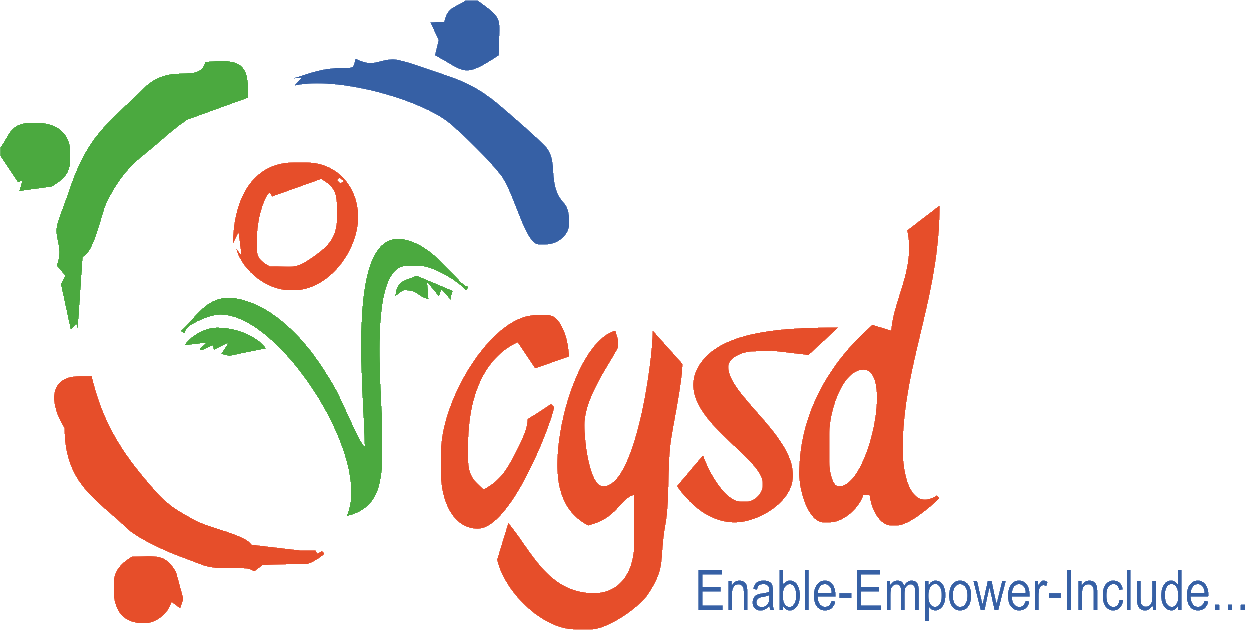

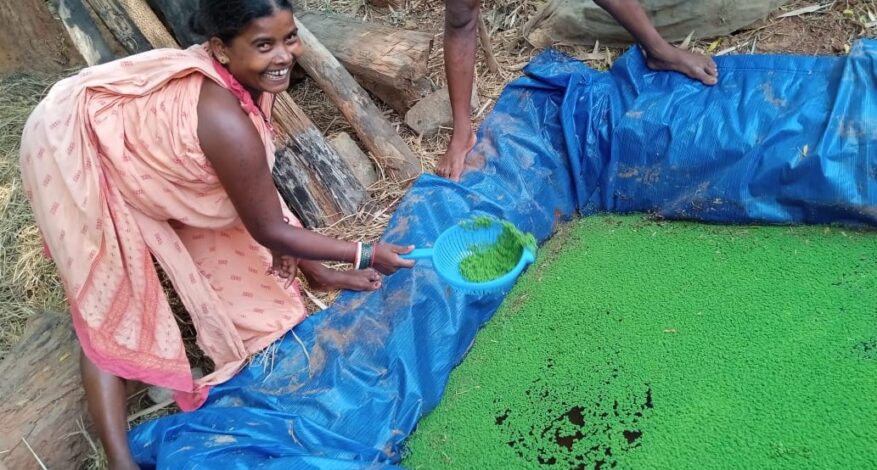
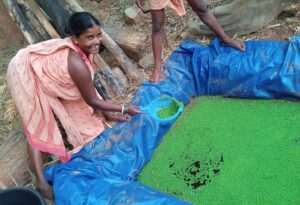 With assistance from the Veterinary Department, these 25 families have received Azolla saplings along with Rs. 1,500/- for each family to establish an Azolla pit. The process involves filling the pit with water and allowing the saplings to grow for 15 days. Once Azolla is fully grown, a portion remains in the water while the rest is mixed into the fodder for cattle and goats. This not only reduces the cost of buying livestock feed but also fosters community building and interdependency.
With assistance from the Veterinary Department, these 25 families have received Azolla saplings along with Rs. 1,500/- for each family to establish an Azolla pit. The process involves filling the pit with water and allowing the saplings to grow for 15 days. Once Azolla is fully grown, a portion remains in the water while the rest is mixed into the fodder for cattle and goats. This not only reduces the cost of buying livestock feed but also fosters community building and interdependency.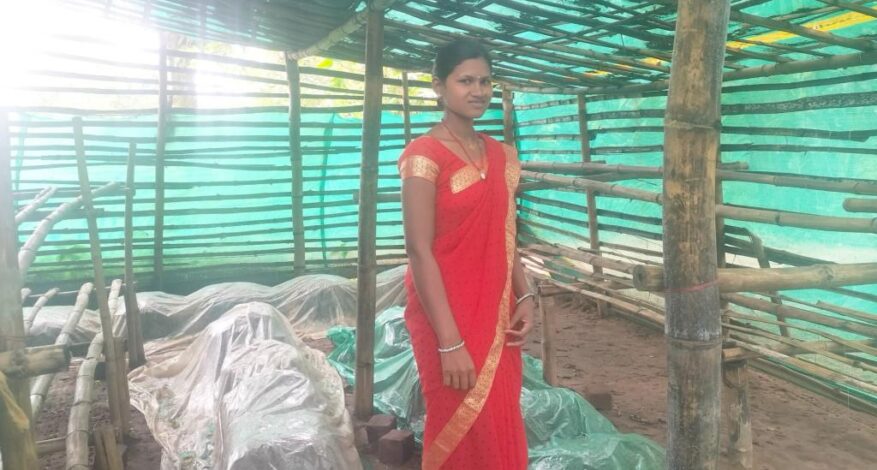
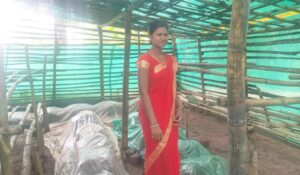 In the remote areas of Kosagumuda Block in Nabarangpur District, there is a village called Udanguda in the Motigaon Gram Panchayath. With 40 households, due to a lack of knowledge about other livelihood opportunities, they have relied solely on agriculture. However, because there is no proper irrigation facility, they can only harvest one crop per year. During the non-farming season, they turn to Non-Timber Forest Products (NTFP) to earn a living. Sustainable livelihood generation has been a major problem in villages like Udanguda. The lack of education and awareness about diversifying livelihood opportunities has made it difficult for these people to meet their basic needs. To help them earn a stable and profitable living, CYSD has launched the South Odisha Livelihood Program. Under this initiative, the people of Udangudi have been introduced to mushroom cultivation. Three women Self-Help Groups (SHGs) from the village have been identified and provided with training in mushroom cultivation through a collaborative approach with NABARD.
In the remote areas of Kosagumuda Block in Nabarangpur District, there is a village called Udanguda in the Motigaon Gram Panchayath. With 40 households, due to a lack of knowledge about other livelihood opportunities, they have relied solely on agriculture. However, because there is no proper irrigation facility, they can only harvest one crop per year. During the non-farming season, they turn to Non-Timber Forest Products (NTFP) to earn a living. Sustainable livelihood generation has been a major problem in villages like Udanguda. The lack of education and awareness about diversifying livelihood opportunities has made it difficult for these people to meet their basic needs. To help them earn a stable and profitable living, CYSD has launched the South Odisha Livelihood Program. Under this initiative, the people of Udangudi have been introduced to mushroom cultivation. Three women Self-Help Groups (SHGs) from the village have been identified and provided with training in mushroom cultivation through a collaborative approach with NABARD.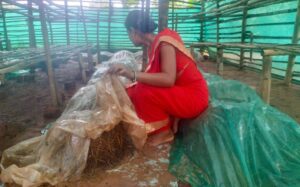 At present, 30 women from three SHGs have embarked on mushroom cultivation and are earning a very profitable source of income. Instead of relying on NTFPs during the non-agricultural seasons, these women farmers are now making a significant contribution to their household income, averaging around ₹14,000 annually. Each of these three Self-Help Groups consists of 10 members. Over the past seven months, each member has set up between 25 to 30 straw beds for mushroom cultivation. Depending on the type of mushroom being cultivated, each of these beds can yield 2 to 3 harvests. Every harvest typically produces mushrooms with a total weight of around 1 kilogram. In the market, each kilogram of mushrooms is valued at approximately ₹270 to ₹300. Considering the investment required to prepare the straw and procure the spawns for 30 beds, which amounts to ₹1,800, the returns are usually 9 to 10 times higher than the initial investment.
At present, 30 women from three SHGs have embarked on mushroom cultivation and are earning a very profitable source of income. Instead of relying on NTFPs during the non-agricultural seasons, these women farmers are now making a significant contribution to their household income, averaging around ₹14,000 annually. Each of these three Self-Help Groups consists of 10 members. Over the past seven months, each member has set up between 25 to 30 straw beds for mushroom cultivation. Depending on the type of mushroom being cultivated, each of these beds can yield 2 to 3 harvests. Every harvest typically produces mushrooms with a total weight of around 1 kilogram. In the market, each kilogram of mushrooms is valued at approximately ₹270 to ₹300. Considering the investment required to prepare the straw and procure the spawns for 30 beds, which amounts to ₹1,800, the returns are usually 9 to 10 times higher than the initial investment.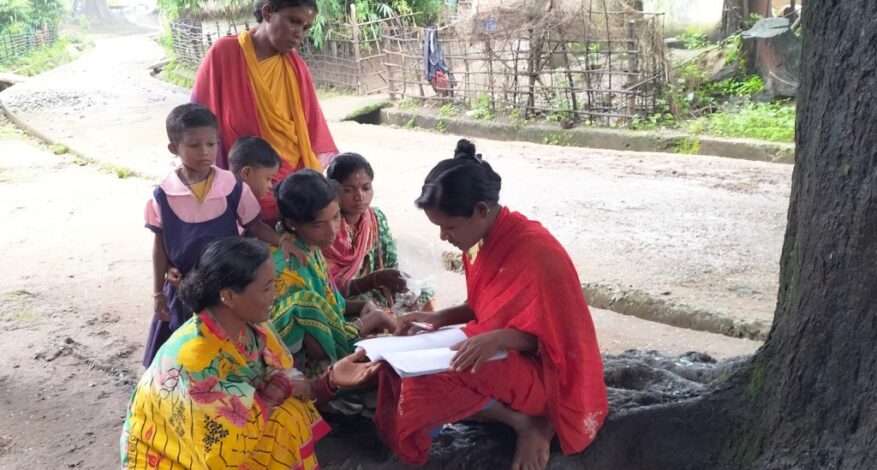
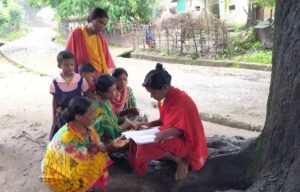 CYSD, through its intervention, has promoted a Producer Group comprising 7 Self-Help Groups (SHGs) in the village, named Ma Tulasi. These SHGs empower women from these rural tribes to become independent and financially stable. In March of this year, Adisakthi SHG and Gramadevi SHG, out of the seven, came up with a collaborative idea to establish a vegetable nursery. The Watershed project in the area has provided each SHG with financial support of ₹25,000.
CYSD, through its intervention, has promoted a Producer Group comprising 7 Self-Help Groups (SHGs) in the village, named Ma Tulasi. These SHGs empower women from these rural tribes to become independent and financially stable. In March of this year, Adisakthi SHG and Gramadevi SHG, out of the seven, came up with a collaborative idea to establish a vegetable nursery. The Watershed project in the area has provided each SHG with financial support of ₹25,000.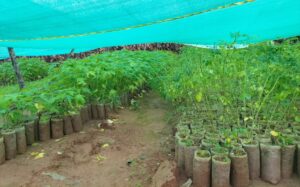 Dauna Majhi, the president of Gramadevi SHG, explained that they cultivate seedlings such as Guava, Papaya, Chili, Drumstick, Tomatoes, and Brinjal. She emphasized that the nursery is helping them generate income, which is being used for the development of their SHGs and to support their livelihoods
Dauna Majhi, the president of Gramadevi SHG, explained that they cultivate seedlings such as Guava, Papaya, Chili, Drumstick, Tomatoes, and Brinjal. She emphasized that the nursery is helping them generate income, which is being used for the development of their SHGs and to support their livelihoods In the remote areas of Koraput District, specifically in the Dandabadi Gram Panchayath, there is a village called Padapadar with around 60 households. The primary issue in this village is the deeply entrenched problem of child marriage. No one in this village remains unmarried beyond the age of 17, and typically, marriages occur as early as age 15. There are two major reasons why this social problem continues to persist: i) Parents lack awareness regarding the importance of education, adolescent health, and menstrual health; and ii) The absence of a proper education system results in high dropout rates.
In the remote areas of Koraput District, specifically in the Dandabadi Gram Panchayath, there is a village called Padapadar with around 60 households. The primary issue in this village is the deeply entrenched problem of child marriage. No one in this village remains unmarried beyond the age of 17, and typically, marriages occur as early as age 15. There are two major reasons why this social problem continues to persist: i) Parents lack awareness regarding the importance of education, adolescent health, and menstrual health; and ii) The absence of a proper education system results in high dropout rates.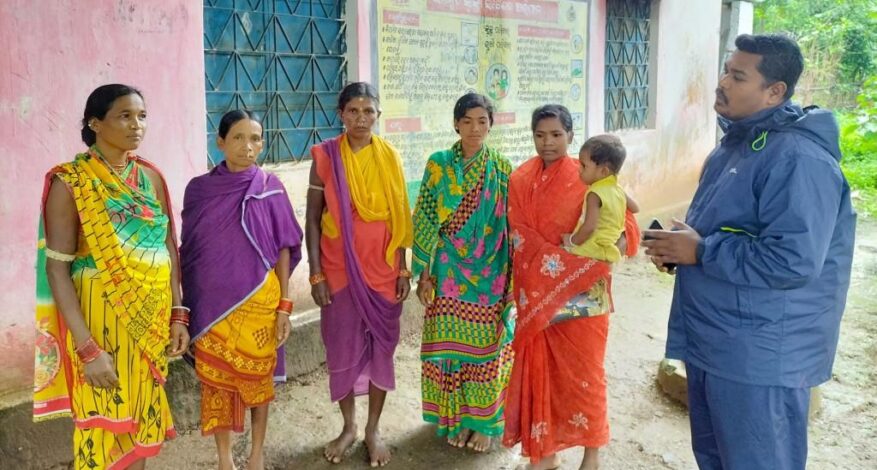
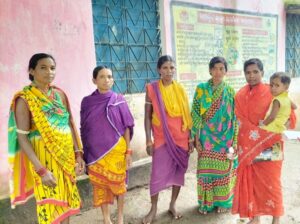 The community and citizen leader of Patiapadar is Dharmendra, a 25-year-old farmer. He has actively engaged in identifying the numerous challenges faced by the villagers and working towards potential solutions. Dharmendra expressed his concerns, stating, “The residents of this village encounter several difficulties, ranging from an unstable income to the inability to access government schemes and policies. These circumstances have kept the people of this village in isolation. Witnessing the struggles of the villagers, I have always aspired to make a positive difference for them. My opportunity to do so arose through CYSD when I became a community leader.”
The community and citizen leader of Patiapadar is Dharmendra, a 25-year-old farmer. He has actively engaged in identifying the numerous challenges faced by the villagers and working towards potential solutions. Dharmendra expressed his concerns, stating, “The residents of this village encounter several difficulties, ranging from an unstable income to the inability to access government schemes and policies. These circumstances have kept the people of this village in isolation. Witnessing the struggles of the villagers, I have always aspired to make a positive difference for them. My opportunity to do so arose through CYSD when I became a community leader.” However, Dharmendra’s primary focus is on addressing the central issue: preventing villagers from leaving in search of livelihood opportunities elsewhere. He expressed his goal, stating, “I aspire for our people to remain in the village, earn their livelihood here, and actively contribute to the village’s development. My aim is to assist them in creating sustainable livelihood opportunities that provide a stable income throughout the year.” Dharmendra’s determination to enhance the quality of life for his fellow villagers reflects his commitment to fostering lasting positive change within the community.
However, Dharmendra’s primary focus is on addressing the central issue: preventing villagers from leaving in search of livelihood opportunities elsewhere. He expressed his goal, stating, “I aspire for our people to remain in the village, earn their livelihood here, and actively contribute to the village’s development. My aim is to assist them in creating sustainable livelihood opportunities that provide a stable income throughout the year.” Dharmendra’s determination to enhance the quality of life for his fellow villagers reflects his commitment to fostering lasting positive change within the community. With very little time to spare, Dharmendra needed to act quickly. He approached the ASHA worker in his village to initiate the birth certificate application process, only to discover that the baby’s birth had not been officially registered. Dharmendra recounted, “The baby’s health was deteriorating rapidly, and time was running out. I immediately initiated the process to obtain the baby’s birth certificate. With the assistance of a legal advocate, we obtained an affidavit. This was submitted to the district collector’s office, and the process had begun. Within two weeks, the birth certificate was granted. It was then issued at the hospital, and the operation was successful. The baby is now healthy and hailing. I am incredibly grateful to have been part of a life-saving endeavor,” Dharmendra expressed.
With very little time to spare, Dharmendra needed to act quickly. He approached the ASHA worker in his village to initiate the birth certificate application process, only to discover that the baby’s birth had not been officially registered. Dharmendra recounted, “The baby’s health was deteriorating rapidly, and time was running out. I immediately initiated the process to obtain the baby’s birth certificate. With the assistance of a legal advocate, we obtained an affidavit. This was submitted to the district collector’s office, and the process had begun. Within two weeks, the birth certificate was granted. It was then issued at the hospital, and the operation was successful. The baby is now healthy and hailing. I am incredibly grateful to have been part of a life-saving endeavor,” Dharmendra expressed.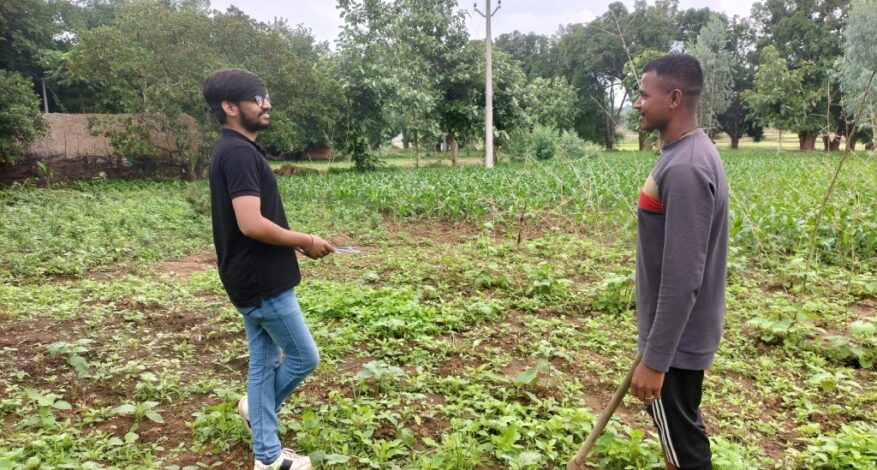
 Iswar’s aspiration to improve his village caught the attention of CYSD’s community facilitators. When searching for an engaged community member, the residents of Gundalia Guda were determined that Iswar should become their community leader. Iswar admitted, “Initially, I had no idea what it meant to be a community leader or what responsibilities it entailed. However, I was thrilled to learn that this role could be my gateway to developing my village.”
Iswar’s aspiration to improve his village caught the attention of CYSD’s community facilitators. When searching for an engaged community member, the residents of Gundalia Guda were determined that Iswar should become their community leader. Iswar admitted, “Initially, I had no idea what it meant to be a community leader or what responsibilities it entailed. However, I was thrilled to learn that this role could be my gateway to developing my village.” Iswar emphasized, “Once the road is constructed, I believe that many of the village’s problems can be resolved. Lack of proper connectivity has hindered access, especially during medical emergencies.” Iswar recounted that during the rainy season, he and other villagers had to carry patients and walk nearly 2 kilometers on muddy roads to access medical facilities. “I’m delighted that one of the village’s major issues has been addressed, and it fills me with pride to have played a vital role in bringing about this change,” he expressed.
Iswar emphasized, “Once the road is constructed, I believe that many of the village’s problems can be resolved. Lack of proper connectivity has hindered access, especially during medical emergencies.” Iswar recounted that during the rainy season, he and other villagers had to carry patients and walk nearly 2 kilometers on muddy roads to access medical facilities. “I’m delighted that one of the village’s major issues has been addressed, and it fills me with pride to have played a vital role in bringing about this change,” he expressed.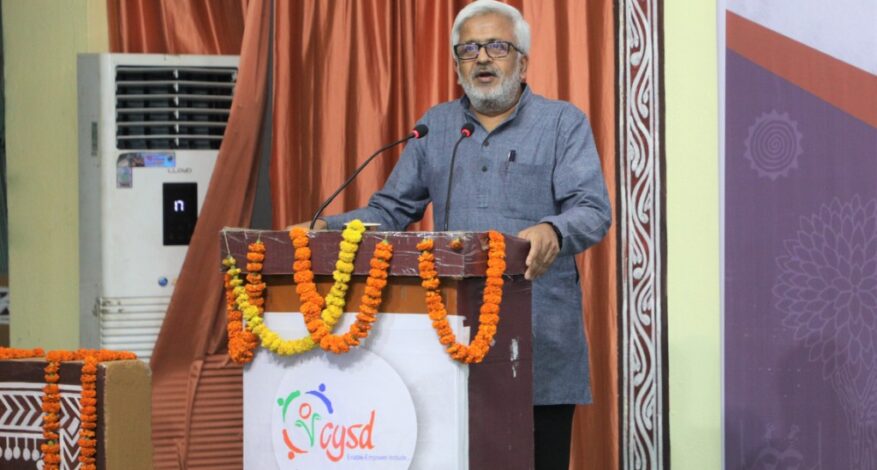
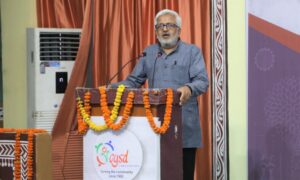 “Poverty is a state, where a person lacks the basic capacity to participate effectively in the society. Poverty in a democracy is a denial of services and opportunities to lead a long, healthy, creative life and enjoy a decent standard of living. We see poverty as an instrument which normally facilitates too much capital to grow. There is great potential of human and social capital for the poor to grow or reserve. People with too much capital are a causality. Therefore, we are focusing on sensitising the community on the development activities undertaken through various flagship schemes and programmes; and also enabling people to understand their roles and responsibilities and expand their capacity towards building a sustainable community.
“Poverty is a state, where a person lacks the basic capacity to participate effectively in the society. Poverty in a democracy is a denial of services and opportunities to lead a long, healthy, creative life and enjoy a decent standard of living. We see poverty as an instrument which normally facilitates too much capital to grow. There is great potential of human and social capital for the poor to grow or reserve. People with too much capital are a causality. Therefore, we are focusing on sensitising the community on the development activities undertaken through various flagship schemes and programmes; and also enabling people to understand their roles and responsibilities and expand their capacity towards building a sustainable community.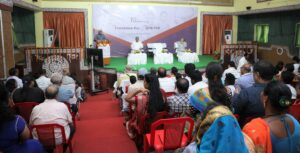 Nations around the world are challenged on how to ensure the benefits of governance and development reach the last mile. When all things are done, what really matters is whether the person at the last mile is feeling the impact of, and getting the benefits of good governance. Democracy calls for a shift from Jamindari to Jan Bhagidari or effective partnership. The partnership is very dynamic which requires relationship building that continues for a longer time. It demands both independence and interdependence in terms of behavioural competency, functional competency, and domain competency. It requires both changes in the mindset and mindset to change. We have to develop an attitude to learning from the community, the CSOs, the government, the media-building narratives, and the academia. Let’s work together and learn from each other. Influencing the state on how to work with other actors including the CSOs; and mobilising the CSOs to work with the government is very critical. Above all, the community is always at the centre. Starting from brainstorming with the community for project formulation/designing, to participatory project implementation, monitoring & evaluation, review-cum-reflection are important for the success of the project.
Nations around the world are challenged on how to ensure the benefits of governance and development reach the last mile. When all things are done, what really matters is whether the person at the last mile is feeling the impact of, and getting the benefits of good governance. Democracy calls for a shift from Jamindari to Jan Bhagidari or effective partnership. The partnership is very dynamic which requires relationship building that continues for a longer time. It demands both independence and interdependence in terms of behavioural competency, functional competency, and domain competency. It requires both changes in the mindset and mindset to change. We have to develop an attitude to learning from the community, the CSOs, the government, the media-building narratives, and the academia. Let’s work together and learn from each other. Influencing the state on how to work with other actors including the CSOs; and mobilising the CSOs to work with the government is very critical. Above all, the community is always at the centre. Starting from brainstorming with the community for project formulation/designing, to participatory project implementation, monitoring & evaluation, review-cum-reflection are important for the success of the project.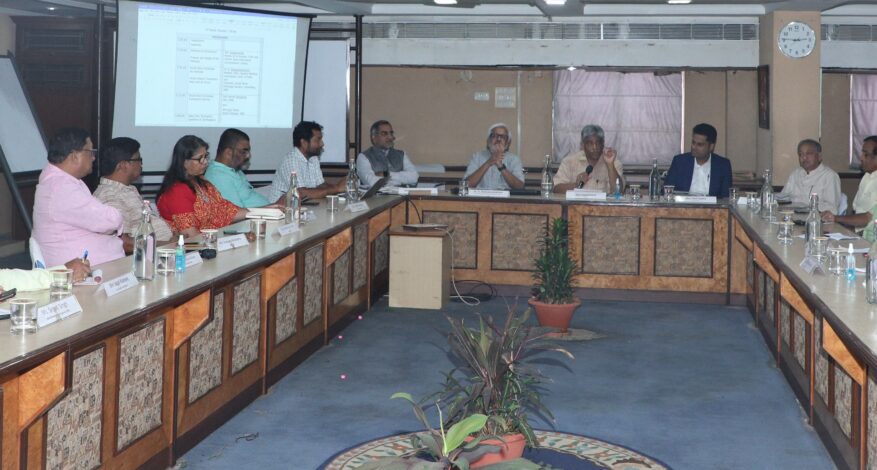
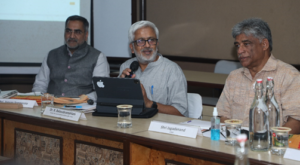 Keeping this in mind, a dialogue of Civil Society on the Social Stock Exchange Framework was organized by CYSD on 23rd March 2023 in Bhubaneswar on the eve of its 41st Foundation Day. Dr. R Balasubramaniam, Founder of GRAAM and Chair of the SSE Advisory Board, currently Member of the Capacity Building Commission, Govt. of India who joined this dialogue assisted the Odishan CSO representatives in clarifying various aspects of the SSE framework. Moreover, a few senior officials like, Mr. Jeevan Sonparote from Securities & Exchange Board of India (SEBI) and Mr. Avik Gupta from National Stock Exchange of India (NSE) also joined the workshop and guided the delegates on how their NPOs can be registered with SSE before initiating fund raising: eligibility criteria for Social Enterprises including Disclosures, Process overview and Value Proposition.
Keeping this in mind, a dialogue of Civil Society on the Social Stock Exchange Framework was organized by CYSD on 23rd March 2023 in Bhubaneswar on the eve of its 41st Foundation Day. Dr. R Balasubramaniam, Founder of GRAAM and Chair of the SSE Advisory Board, currently Member of the Capacity Building Commission, Govt. of India who joined this dialogue assisted the Odishan CSO representatives in clarifying various aspects of the SSE framework. Moreover, a few senior officials like, Mr. Jeevan Sonparote from Securities & Exchange Board of India (SEBI) and Mr. Avik Gupta from National Stock Exchange of India (NSE) also joined the workshop and guided the delegates on how their NPOs can be registered with SSE before initiating fund raising: eligibility criteria for Social Enterprises including Disclosures, Process overview and Value Proposition.